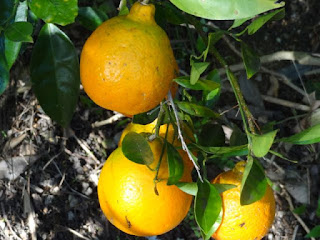Our June 2 visit to a Fernmount (near Bellingen) garden showed the early ravages of our mild Autumn. Quite a few deciduous trees (Pecan Nut, Pomegranate) had lost most of their leaves. The citrus, however, were madly fruiting.
We viewed a Yam Bean plant then dug the tuber for afternoon tea. The bean seeds are poisonous but the tuber is cool and refreshing. Best of all we can all grow it in the mild climate. We could see the actual
inedible Yam Bean seeds on the vine. The seeds are soaked to double in
size before planting in Spring.
 |
| Inedible bean of the Yam Bean |
Afternoon tea is over and all that remains of the freshly dug Yam Bean
are two slices. The cut Yam Bean was a hit as a stick for dips. The verdict was that the taste was refreshing. Yea for a healthy dip stick!

On the
bench is another whole Yam Bean. The strips of skin peel off easily with
a knife.
Here are some of the plants still fruiting in the food forest/orchard. Also shown are some of the plants we are hoping will fruit on a north facing slope but in this less than tropical climate.
An Australian Sweet Lime hybrid does very well .
This Bilimbi tree has yet to fruit. It is a pretty tree but will lose its leaves from the cold wind.
The Carambola (Star Fruit) has fruited generously. This seedling plant seems less susceptible to a rust than the parent plant.
Dried edible Hibiscus pods in front of lush Cassava leaves.
The Coffee beans yet to ripen.We must watch the birds do not spread the seed. Apparently a handful of seeds makes a cup of coffee and the seeds can be roasted in a bench top popcorn machine.
Cumquats are delicious.
The Dragon Fruit has yet to fruit but grows well.
Giant Russian Cucumbers, a mild tasting variety that grows well in this climate. This is a third generation seed grown in this garden.
Golden Grumichama (or Black Grumichama) makes an excellent hedge. The fruit are cherry sized and very sweet.
This Kale just keeps growing.
The Lemonade is covered in fruit.
 |
| Loofah |
The Loofah vine is loaded with fruit to be processed to make scrubbers. The small fruit are edible losing their rank odour when cooked like a zucchini.
Mandarins are always popular.
Mexican Weeping Bamboo is perfect for stabilising the bank of the dam.
Meyer Lemons are not terribly productive in this location.
Pecan Nut pods amid their autumn leaves.
A pomelo is yet to ripen.
This Purple Podded Pea is not as half as productive as Snow Peas in this climate but it does produce podded peas.
This Soursop loses leaves over Winter but is still growing well in Summer. It is yet to fruit.
 |
| Sprouting garlic |
Garlic grows well in a pot.
This Star Gooseberry (an Asian fruit) is yet to fruit.
Unripe Macadamia Nuts hang from the tree.
A mix of Sweet and Lemon Basil grows well in the raised bed.
Our Tamarillos are still fruiting but no longer flowering.
Tangerines grow as well as the other citrus.
This Thornless Blackberry produced a few sweet fruit this season. The fruit is not always very sweet.
This Tropical Apricot is growing strongly. We hope it fruits.
A mixed bed with Tumeric and edible Ginger.
Villa Franca lemon
This White Guava is sweet with a slight trace of lemon. At this time of year it is fruit fly free.
White Mugwort, a useful herb to add to the nests of the chickens and to their drinking water to kill parasites.
We hope this Wild Herbert Cherry (an Australian native from the tropics) will thrive in this climate.
We have a glut of pumpkins but are learning to use them in curries, vegetable chili con carne, cakes, soups etc. They do not go to waste.

























.jpg)




.jpg)






